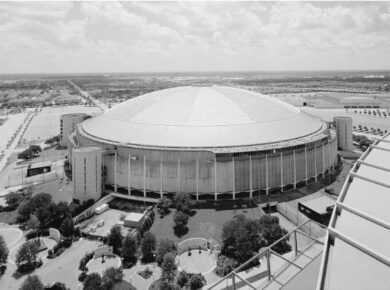Together with Henry Van de Velde, Horta is considered the most important representative of Art Nouveau. Horta did an apprenticeship with Alphonse Balat, where he gained experience in cast iron and glass architecture. Together, Balat and Horta designed the Royal Greenhouses of Laeken.

Photo: Henry Townsend
Around 1885 Horta started his own practice. His first buildings were three houses in the street Twaalfkameren 49-53 in Ghent. These were the only buildings by Horta in Ghent. In 1888 he became a member of the Masonic Lodge and expanded his social network, which from 1893 onwards resulted in commissions for civic housing and shops, mainly in Brussels. Horta’s work for a select group of the Brussels upper middle class dates from this period.

Photo: Bastin-Evrard ©urban.brussels
The Tassel House (1893-1896)
The house for ULB professor Emile Tassel marked the beginning of a new style within Art Nouveau. This style was innovative not only in the use of typical decorative forms, but also in the experimental arrangement of the interiors. By using different levels, windows, conservatories, staircases and skylights, it brought light to all floors and rooms and created an unprecedented sense of space for bourgeois houses.

Photo ca 1900
The most striking innovation lies in the use of glass and cast iron in the façade and in their relationship to the stonework. The still rather massive and short columns of the ground floor change on the first floor into much finer iron columns resting on a stone reinforcement, and on the top floor into two iron columns detached from the balcony.

Photo: Karl Stas
You can see the iron plates with their clearly visible rivets, to which the columns are attached on all floors; this shows that Horta wanted to demonstrate construction techniques, which was unheard of in private houses at the time and may be considered a clear expression of modernity.

Photo: Bastin-Evrard ©urban.brussels
One has the impression that in this house Horta brought together all his wishes, dreams and ideas. Horta was not alone in his urge for innovation. Architects all over Europe and the rest of the world dreamed, like him, of freedom and innovation. Gaudi, Mackintosh, Eiffel, Sullivan, Wright, Hoffmann, Gropius or Loos… they all shared the urge to make tabula rasa with the principles they had learned.
About the Author:

Bruno Dursin – Managing Director at Believe in Steel. Bruno has more than 30 years of experience in promoting steel & steel solutions. His clients benefit from his extensive network within the building industry.



